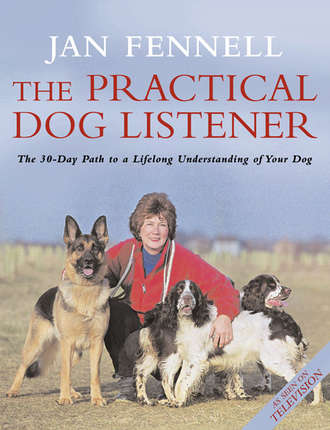
Полная версия
The Practical Dog Listener: The 30-Day Path to a Lifelong Understanding of Your Dog


The Practical Dog Listener
The 30-day path to a lifelong understanding of your dog
Jan Fennell

For Sasha, Barmie and Raffie
Also to Sadie, the star of this book 5/12/1995–28/10/2005
Table of Contents
Cover Page
Title Page
CAUTION
INTRODUCTION
PROLOGUE
PART ONE: Day-1
PART TWO The First 48 Hours
PART THREE: Days 3–7
PART FOUR: Days 8–14
PART FIVE: Days 15–21
PART SIX: Days 22–30
PART SEVEN: Day 31 Onwards…
Epilogue
Images
Index
Acknowledgements
About the Author
Copyright
About the Publisher
CAUTION
It is important to state here that my method cannot remove the aggressive tendencies of any dog. Certain breeds have been raised specifically for the purpose of fighting, and my methods will never be able to alter their potentially savage nature. What my method can do is allow people to manage their dogs so that this aggressive instinct is never called upon. Please exercise the greatest of caution when working with such dogs.
INTRODUCTION
The response to the publication of my first book, The Dog Listener, has been truly humbling. I seem to have struck a chord with so many people who share my belief that humans and dogs can enjoy a peaceful and rewarding coexistence. The thought that many of these people are now successfully implementing the compassionate training method I outlined, and so are learning to understand the dog’s own language, heartens me enormously.
The many words of support I have received since publication echo those I first heard on a much smaller scale when I began treating problematic dogs almost ten years ago. At the time, people raised on the idea of ‘obedience training’, of sublimating the dog’s will to that of its human ‘master’, were overwhelmed to discover that dogs could coexist with humans while still exercising their own free will. They were amazed to discover that, as I like to put it, the best form of control is using the dog’s self-control.
People’s responses to the practicalities of applying my method have conformed to an equally familiar pattern. And it was here that the seeds of the idea for this book were sown. From my earliest experiences in dealing with owners on a one-on-one basis, I quickly learned that no two dogs, no two homes and no two relationships between dog and owner are the same. On the one hand, this is one of the main reasons why my work remains such a source of fascination to me. However, this also makes it natural that my work divides itself into two distinct phases: the home visit itself and the post-visit, or backup, service.
During the crucial first consultation, it is my job to explain and demonstrate the principles that underpin my work. From there, I go on to offer owners basic instructions on how to implement my method. Many owners are able to replicate my method almost instantaneously, yet just as many require ongoing supervision. This is no criticism of any of them: while, at heart, my method is a simple one, the practicalities of implementing it are at times demanding. Some people don’t have the time or the resources to devote themselves as fully as others. Some have tried so many different methods, they cannot separate mine from the others. Equally, while I believe all dogs understand and react to my signals in the same way, every dog has a personality that can manifest itself in a different form of behaviour. Some dogs are simply more strong-willed and resistant than others. As a result, I make sure I am always at the end of a telephone line to guide owners through the difficult moments.
My first book was, in many ways, the equivalent of the home visit. Within its pages I outlined my ideas and explained how they evolved through long and hard experience. It was, if you like, my mission statement. Now I have produced this second book as the backup, the practical guide to putting that philosophy to work. The reaction to the first book has helped shape the content of this companion volume. Many of the people who have contacted me since reading The Dog Listener have asked me to develop specific ideas touched on in the first book. Most of them have wanted to apply them to the practical realities of their own situations. Many people, for instance, own more than one dog. Others find it hard to impose themselves on their dog, to present the signals consistently and to interpret their dog’s reaction correctly. Some find it difficult to incorporate my method into their hectic lives. Others have dogs that have displayed behaviour so bizarre, it simply hadn’t occurred to me it existed! I have no doubt there are dogs out there with traits that I still haven’t imagined. Nevertheless, I have done my best to cover as many of the unexplored areas as I can in this book.
My goal is to allow anyone to implement my method. So, to make it as accessible as possible, I have divided what follows into a guide through the key phases of the crucial first thirty days. I am adamant in my belief that the work of a responsible and caring owner begins even before a dog arrives within the home. With this in mind, I have included a section on the all-important preparations required too. From meeting and corresponding with people, I know how many readers enjoyed hearing of my adventures in treating problem dogs, so I have made sure I have included as many anecdotal examples as possible to illustrate my points. In response to readers’ comments, there are also step-by-step photographs.
There are goals that can be achieved at regular intervals throughout this method. For instance, it is my belief that most dogs and their owners can attain a basic new understanding of each other within two days. Within a week, I believe most owners should be ready to begin taking their dogs out on walks in public places. At the same time, I am not so foolish as to claim that my method will turn even the most difficult and badly behaved dog into the perfect companion within a month. Nor am I going to promise that every dog’s progress will conform to precisely the same pattern. If you find your dog is not doing something within four, fourteen – or even forty – days, you should not despair. Results will come with application and patience. Provided you persevere and apply my ideas consistently, even the most desperate owner should see huge improvements within this first month. Perhaps even more importantly, you should also have changed your perspective of your dog. Both of you should then be ready to join the growing band of owners and dogs that are enjoying a happier and more fulfilling life together.
Lincolnshire, England, October 2001
PROLOGUE
Home Truths
In the decade since I first began developing my ideas about communicating with dogs, I feel as if I’ve been travelling a long, mysterious – and seemingly endless – road. If I am honest, it has been a journey filled with more than its fair share of wrong turns and blind alleys. Yet around every corner there has been something new to learn.
My travels have now taken me far from home, and the close-knit community of friends and fellow dog lovers within which I began my work. It has been a privilege to meet and help – either directly or indirectly – dogs and owners as far afield as Thailand and the United States, New Zealand and France. Wherever I have travelled I have encountered situations that, sometimes subtly, sometimes dramatically, have deepened my understanding and reaffirmed my belief in the principles of the hidden language that underpins dog behaviour. It is ironic, then, that the most powerful and painful lesson of recent times should have been delivered within the confines of my own home.
There’s an old saying that if you want to give God a laugh, you tell him your plans. It never seemed so apt as it did in May 2001. At the time, I must admit, I had been feeling on top of the world. I had travelled to Poland to promote the publication of my first book, The Dog Listener. It was the first time I had ventured abroad to talk about my work. Meeting dog lovers in cities like Warsaw, Lodz and Cracow was an exciting and uplifting experience, something I’d never imagined would happen to me. I was guest of honour at the country’s main dog show and was feted on television shows and at Champagne receptions and dinners; they treated me like royalty. On the plane back from Warsaw, I had much more to look forward to: a follow-up book, planning a series for television in the UK and finalising the details for my trip to New York, for the launch of the American edition of the book in late July – all heady stuff.
It wasn’t long after I had set my suitcases down that I was brought crashing back to earth. God, it seemed, had got wind of my plans. At the time my partner, Glenn, and I shared our home in Lincolnshire with nine dogs. I’d set off to Poland knowing that the oldest of them, my eleven-year-old Jack Russell, Barmie, had been ill for some time. I wrote about Barmie in my previous book. I had come across him at an animal sanctuary where he had been brought after being discovered tied to a concrete block by a piece of rope. He had been horribly emaciated and was trembling: not just because it was winter at the time but also because he was utterly petrified of humans. I dread to think what sort of abuse he had suffered in his earlier life. The sanctuary was ready to put him to sleep because he was too nervous and aggressive to fit into a family home. I took him in and he became the first great test of my compassionate training method, then in its embryonic stage.
In the seven years I’d had him, Barmie had overcome his fear to lead a happy and fulfilled life. He was a bundle of good-natured energy. Unfortunately, because of the damage he’d suffered in his early years, he’d needed a great deal of medication. As he reached the autumn years of his life, it was clear the cumulative effect of the necessary steroids had weakened him. By that Spring his coat was bare – more skin than fur – his liver was enlarged and he was terribly weak. He was vomiting a lot: everything was breaking down. I’d been telling friends before my trip to Poland that I feared the worst. Sure enough, I got back to learn that he was in a pitiful state. I knew his time was at hand.
An even bigger bombshell lay ahead, however. Even before Barmie, my greatest insight into canine behaviour had been provided by Sasha, a beautiful, black German shepherd I had acquired as a puppy. I had begun my search for a new approach to communicating with dogs in 1990 after meeting the ‘Horse Whisperer’, Monty Roberts. Seeing him bring wild and untamed horses under control without resorting to force or violence of any kind had struck a profound chord within me. I had set out to find a way of training dogs in the same non-violent manner, communicating with the dog in its own language in the same way that Monty connected with horses. Sasha had come into my home soon afterwards and immediately proved an inspiration. More than any other of my dogs, Sasha had shown me the startling similarities between the leadership behaviour within the wolf pack and the domestic ‘pack’ of its distant relative, the dog. Without her guiding example, I would never have gained the knowledge I possess today.
Sasha was eight years old. She’d had problems with her waterworks about six weeks earlier, but a course of antibiotics seemed to cure her. About five days before I had flown to Poland the problem returned, only this time she was passing blood. The vet prescribed a stronger antibiotic and asked us to provide a urine sample so that he could work out the precise nature of her problem. When I got back from Poland, Glenn told me he had difficulty getting this from Sasha; she was having trouble passing water of any kind and her stomach had turned into a hard mass.
I had arrived back on a Thursday evening. On the Friday morning we had arranged to take Barmie to the vet. To be honest, I sensed the end was near. That morning he had been sick in the garden and had been unable to lift himself back to his feet after falling. When I described Sasha’s condition to the vet, he told me to bring her along for an examination as well.
While one vet went off to examine Sasha, we went into one of the rooms with Barmie. It was clear now that he was in some pain. We took the decision to have him put to sleep. There are owners who can’t bear to be present at this moment but, for me, it’s so important that the last thing a dog sees is a friendly face, and that’s what I provided for Barmie. At around noon on Friday, I sat there with him and cuddled him as the injection was administered. He was ready to go: he passed away within seconds.
On the way out, we spoke to the vet who was examining Sasha. The early prognosis seemed to be that she had a blockage, perhaps stones. I was so upset about Barmie I couldn’t really think beyond that. I told them to do whatever was necessary, even if it meant operating. To be honest, I assumed the problem was treatable.
It was 3.30pm when the telephone rang again. The vet said: ‘It’s very bad news.’ An x-ray had shown that there was no blockage. Further examination had shown that Sasha’s bladder muscle had stopped working. He would do what he could to stimulate the bladder but he was not hopeful. I put the telephone down in a state of shock. I couldn’t believe what was happening.
Rather than leaving Sasha in the clinic overnight, I brought her home. On Saturday morning I took her back to the vet and left her for more tests. At midday the phone rang again. Ominously, I was told that another vet had been brought in to provide a second opinion. At 2.30pm the phone rang again and a nurse told me that the vets had held a conference and agreed there was nothing that could be done. The nerve had been badly damaged somehow and, while it was possible to drain the bladder with a catheter, this was not something that could be done for any length of time. They could go ahead with exploratory operations but, in their opinion, this was not going to alter things. I was devastated. I remember telling the nurse: ‘I want a miracle.’ She seemed as upset as me. ‘I wish we could give you one,’ she replied gently.
For a while I considered letting the vets go ahead with their exploratory operations. But then I thought about Sasha, the noblest dog I have known, being reduced to this state. As far as I am concerned, there is no justification for prolonging a dog’s life if it is in pain – regardless of how shocking and upsetting it is to the owner. My motto is simple: it’s either them in pain or us in pain, and it should never be them. So it was that, for the second time in two days, Glenn and I drove to the clinic to have one of our beloved dogs put to sleep. We were both in a terrible state. When Sasha passed away, I cuddled her and simply said: ‘Thank you.’
In the days that followed, I went through a whole range of emotions. Most of the time I felt sick inside. My head was spinning. My whole body hurt. I felt guilt and wondered whether I was being punished for something I had done. I felt anger that these dogs had been taken from me. I had wondered how I would be able to carry on with my work. In one of my few lighter moments, I even found myself agreeing with, of all people, the camp comedian Julian Clary. When he appeared on the BBC show Room 101, Clary – a dog lover – consigned the entire species to ‘Room 101’ because he said they didn’t live long enough. ‘They get under your skin and you love them and then they die,’ he said. How true that is.
For all dog lovers, the loss of the creature they regard as their best friend is a devastating moment. Yet so many owners feel guilty or embarrassed or apologetic. They think they are being stupid. Over the years, I have heard many people say: ‘I want to fall apart. I can’t believe the way I am feeling.’ I always tell them they are entitled to feel that way; their devastation is legitimate and natural. People who say, ‘It was only a dog,’ are the unlucky ones. They don’t even begin to understand the love that a relationship with a dog can bring. Grief over the loss of a dog is as genuine as any other bereavement.
I was certainly not in the mood to apologise for feeling the way I did. Yet, in my heart, I knew I could not let these feelings overwhelm me for long. I soon realised I was not going to be allowed to.
When I got back from the vet and walked back into the house that afternoon, I felt like my world had collapsed. Hand on heart, I couldn’t bear to see, let alone play with or cuddle, my remaining dogs. Dogs are such sensitive creatures, it was inevitable the pack would pick up on this. The remainder of my pack was made up of Sasha’s daughter, Sadie, and six springer spaniels. These were Molly, aged five, and her children, Jake and Jen; Jen’s one-year-old children, Reef and Opal; and another three-year-old springer, Ceri, and her two ten-week-old puppies, Todd and Gabby.
It was Sadie, perhaps predictably, who signalled her reaction first. While the others looked at me as normal when I came in, Sadie hung back. She kept her head hung low, as if she couldn’t bear to catch my eye: I’m sure she sensed what had happened. To be honest, I couldn’t bring myself to look at her either.
Tensions had been building within the house throughout the preceding few days. Sasha had been the most powerful personality within my canine pack. Her absence had thrown all the dogs out of kilter. We had already sensed an atmosphere and, before leaving for the vet that final time, had separated the dogs into four separate groups in different areas of the house.
By the time we arrived home it was late afternoon, almost feeding time. Glenn went through to the kitchen to organise the dogs’ meal. We were both in such a state, however, that neither of us was thinking straight. And it was here that we made the sort of elementary mistake I spend my working life trying to prevent in other homes. We just released the dogs into the kitchen at the same time. Within a split second, all hell had broken loose.
Molly attacked Ceri in the most savage and direct way possible. She tore into her with a vengeance. Within another split second, Jen had joined in the fight on her mother’s side. Even Sadie pitched into the mêlée. To see your dog being attacked by a stranger’s animal is deeply distressing. To see your own dogs trying to tear each other to pieces was one of the most upsetting things I’ve seen in my life. It was a no-holds-barred confrontation. Wounds were opened and there was blood on the floor. The fact that neither Glenn nor I was badly bitten was more down to luck than judgement.
For a few brief seconds it was too much for me, I couldn’t handle it. I can remember sobbing and screaming. At that moment I was confused and angry: how could they do this now? We had lost Sasha and all they could do was fight. It was only after we had pushed all the dogs into different areas of the house that my head began to clear and my senses returned.
It was not long before I recognised what had happened: it was blindingly obvious. For the last ten years I have developed my ideas about the dogs’ belief in the hierarchical ‘pack’ system. I know, perhaps better than most, that a pack must – at all times – have a clearly defined chain of command and, in particular, a leader.
That afternoon, my dogs knew instinctively that there was something terribly wrong within the pack. It was worrying enough that the canine leader, Sasha, was not there. Even worse was the fact that the overall leaders, myself and Glenn, were effectively absent as well. The dogs had spent a few moments in our company before deciding we were about as convincing leaders as a couple of blancmanges. They knew that, for the pack to survive, its leadership had to be re-established immediately. The queen was dead, now it was a case of long live the queen. Molly’s attack on Ceri was the opening salvo in the leadership battle. As the atmosphere calmed a little, I knew I had fallen into a trap. And I knew I had a monumental problem on my hands. It would take me weeks to even begin to reach a solution.
Naturally, the work I had to undergo to restore a sense of order and equilibrium within my pack will feature at intervals in the pages that follow. But I have chosen to begin with this story for another reason. In the days, weeks and months that followed those dreadful forty-eight hours, my anger slowly gave way to other emotions. I felt sorrow, bewilderment and a sense of loss. But, as things returned to something resembling normality, I felt a sense of gratitude too. It was a close friend who sowed the seed when she said to me: ‘Those dogs were put here for a purpose. Sasha and Barmie have served that purpose, and now they have moved on.’ She was absolutely right.
If it had not been for the inspiration Sasha and Barmie provided, I would not have known how to deal with the problems ahead, how to restore harmony to a family that had been left heartbroken by their parting. In time I realised that their legacy was going to live on. These two very different but equally lovable animals were the beacons that drove me on and made me believe it was possible to communicate with dogs.
In death – as in life – the two dogs were still showing me the way ahead. It was not simply that my remaining pack’s instinctive, animal behaviour had confirmed all that Sasha and Barmie had first shown me. More importantly, as I thought about the events of that May, I saw something else: that communicating with our dogs is not a matter of cold, calculating science. Dogs, like humans, have powerful, and sensitive, personalities of their own. Our relationships with them are constantly changing, and we must be able to adapt with them. This was the challenge that faced me personally at that time. And it is a challenge that faces all dog owners, day in, day out. Again, this is something I hope to reflect in the pages to come.
It would, then, be impossible for me to continue this book without remembering – and thanking – Sasha and Barmie. These pages are the continuation of the work they first inspired. They may have gone from my arms but they have not gone from my heart.
PART ONE: DAY-1
A Reintroduction to Dog Listening
When I saw my dogs attacking each other with such force after Sasha’s death, I was witnessing a ritual that dates back thousands of years. It was around 12,000 BC that the modern dog, Canis familiaris, evolved from its ancient ancestor, Canis lupus, the wolf. In the centuries that have followed, the two animals have followed entirely different evolutionary paths. While the wolf has remained, to all intents and purposes, the same animal, the dog has multiplied into myriad breeds. While the wolf has remained in the wild, the dog has been domesticated. And while the wolf’s life remains rooted within the same social environment – the pack – the modern dog has become integrated into human society, often living in isolation from other members of its species. On the surface, then, it may appear that the two have very little in common today. Nothing could be further from the truth.
At the beginning of the twenty-first century, our knowledge of our ancient Homo sapiens cousins deepens almost daily. Rather than fading with time, our understanding of their physiology and psychology seems to loom into focus more and more. And, as this happens, so science is growing increasingly certain that much of modern human behaviour remains rooted in this Stone-Age past. Many of our most basic instincts, from our mating rituals to our attitude to other tribes, date back to the cave-dwelling experience of our ancestors. When you think about it, this makes perfect sense. In the great scheme of things, we have existed on this planet for barely any time at all. If the lifetime of the earth is a single day, man’s time on the planet amounts to barely a few minutes. Our circumstances and surroundings may have changed rapidly, but our brains – and therefore our fundamental natures – have hardly evolved from those times. If this is the case with humans, then it makes sense to assume it applies equally – if not even more strongly – to our closest companions in the animal world, dogs.







